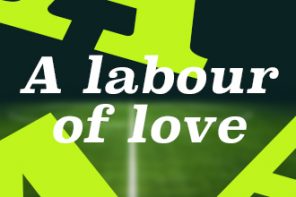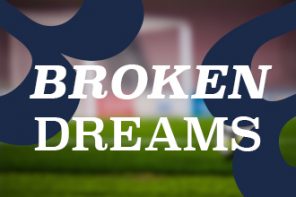Around twenty years ago, a tennis-obsessed Lebanese businessman decided that Dublin should have its own Premiership team, and professed himself the man to make it happen. Sam Hammam, then owner of Wimbledon FC, needed a new home for his itinerant club and he viewed Ireland’s capital as the perfect location. Within a few months of Hammam’s proposal going public in early 1996, his attempts to realise it had pushed his team’s supporters into open revolt against him and catapulted the Irish game into a period of schism.
From the beginning, Hammam, himself an outré figure on the English sporting circuit, enlisted as his man in Ireland one of the country’s most outspoken provocateurs, Eamon Dunphy. A broadcaster and former international footballer, Dunphy was an ideal factotum for Hammam; high-profile and well-connected within various local industries, but also an avid moderniser and a rabid opponent of the League of Ireland since a frustrating spell as a coach at Shamrock Rovers during the seventies.
Unsurprisingly, when Dunphy was given the chance by Hammam to spearhead the project that would become known as the “Dublin Dons”, it was an opportunity he seized. Quickly, he recruited two influential locals, Owen O’Callaghan, a Cork-born property mogul, and U2 manager Paul McGuinness. O’Callaghan’s involvement was significant, possessing as he did something after which Hammam had lusted for decades: the rights to build a large stadium in the suburbs of a major city. Unfortunately for Wimbledon fans, that city was Dublin, not London.
Yet despite the quasi-sacrilegious notion of uprooting a club from one country to another, the move “made economic sense” according to Jim White, writing in The Guardian in 2003. “With no decent club system of its own, Ireland is full of fans of English teams; there is a huge potential market”. Plenty within the country understood that and, by the summer of 1996, the proposal had gained momentum, even receiving backing from the Dublin Chamber of Commerce.
Hammam, meanwhile, claimed to have the support of the Premiership’s other clubs, an assertion which was later given some credence: “Wimbledon’s controversial move to Dublin has been given the go-ahead by their Premiership rivals”, wrote Mark Irwin in the Mirror in April 1997. “[Premiership] chairmen assured Dons owner [Hammam] that they will not oppose his audacious scheme to move the entire Crazy Gang to Ireland”.
But just as rapidly as Hammam’s ersatz consortium had kicked into gear, so too had resistance movements on both sides of the Irish Sea. In London, Wimbledon fans were roused by the news of a potential relocation. “It kind of came out of the blue”, says Kevin Rye, a prominent figure in the Wimbledon Independent Supporters Association, a fan-led movement that stood fiercely against Hammam’s plan, and which would later drive the creation of AFC Wimbledon. “[But] once it was known to be possible, WISA organised protests that fans really latched onto, and within a relatively short period of time, and for the first time, Hammam was on the back foot”.
Wimbledon’s search for a new home was a saga that had rumbled on since the previous decade. Plough Lane, their stadium since before World War One, had come to be seen as a hindrance by club management; too small to make money, too ugly to be loved and quite literally sinking into the earth beneath it. The ground was finally declared unfit for purpose in the aftermath of 1990’s Taylor Report, and Wimbledon FC slipped into what Gerry Cox described as a “descent into near-closure and virtual homelessness”.
They entered a ground-sharing agreement with Crystal Palace at Selhurst Park, with Hammam lamenting the move as a necessary evil and speaking of his ongoing quest to find a suitable patch of land in the immediate area. Some cynics, noted White, “pointed out that he might have been more motivated by the profit he trousered when he sold the Plough Lane site to Safeway for a supermarket development”.
By 1996, Wimbledon fans were accustomed to their status as a dispossessed people, but when talk of Dublin became serious, “Dons’ followers were furious – they would be effectively disenfranchised from the club their money had built”, writes White. “Even with Hammam’s plan to offer discounted flights on Ryanair, how many could afford the time or money to travel to Dublin every other week for home matches?”
Back in Dublin, the domestic football community had also mobilised, with fans and administrators of League of Ireland teams allying to oppose the project. For decades, the competition had been in almost terminal decline, a victim of the player drain and paltry infrastructure. Yet despite poor attendances across the League and sparse national interest in its clubs, zealous defenders of its existence emerged from the woodwork. It appeared as if “the League of Ireland […] could only garner big support when it was at death’s door”, as remarked by Daire Whelan in Who Stole Our Game?
September 1996 brought the first pan-club public meeting to protest Hammam’s idea, held at Wynn’s Hotel in Dublin. Flyers were circulated stating that, “regardless of which club you support the proposed arrival of Wimbledon spells disaster for the domestic game”. The implication was clear: the League of Ireland would fight against further marginalisation. Firmly on its side was the Football Association of Ireland who were, under Bernard O’Byrne, unstintingly opposed to the idea of an incursion on their turf.
But the idea wasn’t going away, despite the New Straits Times writing off the move as “dead in the water” as early as October 1996. Dunphy had pushed the Dons hard in the Irish media. He appealed to the nation on a live TV broadcast: “Ireland has the opportunity to be a first world football country”. The Dublin Dons would be an “Irish club” playing in the English league. Dunphy talked excitedly of player development and keeping Irish players on the island by giving them a worthwhile outlet for their talent. According to the Irish Times, the consortium had even gone so far as to gauge Roy Keane’s interest in the venture.
Dunphy was backed up publicly by some of the more pragmatic observers of Irish sport. For Colm McCarthy, an economist at University College Dublin writing in When Saturday Comes in March 1996, the country needed the Dublin Dons because “Dublin is big enough to support a proper professional club, but the Republic cannot support a professional league for it to play in”. Later that year, Kevin Myers of the Irish Times asked whether “our sporting writers would prefer to be reporting on the titanic struggle between Bray Wanderers and Longford Town, or the gripping encounter between Cork Whoever against Lough Swilly Pirates, rather than on a Dublin team playing in the English premiership?”
This type of argument met with an understandably vocal opposition, but one which had gained a jingoistic edge as the months passed. Writing for the Sunday Tribune in 1997, League of Ireland manager Pat Dolan depicted Wimbledon as “an English club abandoning their home to commercially exploit Ireland’s love of sport”. And “what about the great English export, the soccer lout?” he asked in the same article.
Ireland is no stranger to parochialism and, to those in favour of the Dublin Dons, its football clubs hadn’t hesitated in reverting to type. As Whelan pointed out drily, “English soccer was reviled as being responsible for taking away so many Irish fans; naturally, if the Premiership didn’t exist, League of Ireland grounds would be packed to the rafters every other week”. McCarthy, meanwhile, highlighted among Irish sport as a whole, “a crypto-Provo element who can always be relied on to pander to anti-Brit sentiment”.
But the main problem for Dunphy and his cohorts was simply the nature of their campaign. Dunphy appealed for a commercialist mind-set, long-term strategy and infrastructural development, promising millions worth of investment in academies and facilities and a wholesale revamp of the sport in Ireland. It was an approach betraying little consideration for anyone but those who bought into the progress-at-all-costs concept of the Dublin Dons. Consequently, those who railed against him were able to call on a more emotive, human set of tenets: pride, belief in the virtue of their cause and, ultimately, a desire to uphold the status quo.
Across the water, Wimbledon fans took every opportunity to make their feelings known. By the middle of the 1997/98 season, the famous “Dublin = Death” banners had appeared at Selhurst Park, and jeers directed at club hierarchy by Dons fans were commonplace during that campaign. The ill-feeling became pervasive, even among the coaching staff. According to Mike Ticher in When Saturday Comes, Wimbledon’s Dublin-born manager Joe Kinnear had, in September 1997, “unleashed a tirade of abuse against the Wimbledon fans who booed his team off at half-time against Barnsley”.
Kinnear, a true believer in the Dublin Dons movement, was deeply critical of his team’s fans and bemoaned what he portrayed as an absentee culture. “The truth of the matter is rather different”, counters Ticher. “Last season Wimbledon averaged 15,156, and so far this season they are pushing 17,000 […] A solid 16,000 would have left the Dons looking down on seven other clubs in the First Division”.
Unimpressed by these numbers, Hammam complained continually of his side’s inability to compete with other clubs boasting large attendances and therefore large bank balances. His message was obvious: poor little Wimbledon won’t survive unless it relocates. But even then, TV cash was levelling the playing field. “Above all else”, notes Ticher, “it is the Sky money that has widened the gap between the Premier League and the rest, and Wimbledon’s admirable achievement in holding their status has earned them their full whack”. After BSkyB agreed their infamous deal with the Premier League, Hammam was quoted as saying in May 1992: “I think that this is the best thing that’s happened to football in years”. How ironic, then, that a prime factor in Wimbledon’s continued presence in the top-tier would end up forming an embarrassing counterpoint to Hammam’s claims of inevitable destitution.
Besides, by the end of 1997, Hammam had all but washed his hands of the club after hawking off most of his shares. The possibility of the move to Dublin going through was a bargaining tool for him during negotiations for the sale – after which he still managed to retain an influence at the club – and far from putting an end to talk of leaving London, his selling up merely led to more of the same. Unfortunately for the Norwegians to whom he flogged Wimbledon, the Dublin Dons idea was floundering by the time they took control, shackled by a combination of Anglo-Hibernian fan unrest and administrative uncertainty.
Aside from ground-level resistance, the project was hamstrung by legal obstacles. Officials across the spectrum questioned whether allowing a team based in a country outside the UK to compete in its leagues would have been permissible under Uefa and Fifa regulations. Hammam, however, was willing to take things to a higher level. An article citing a source in London appeared in the Irish Independent in January 1998, stating that “Sam Hammam is seeking clarification from the European Commission in Brussels as to whether his club are legally entitled to move to Dublin … Hammam has sent a letter to the EU’s competitions’ supremo, Commissioner Van Miert, to clarify Wimbledon’s position”.
Hammam may have been confident of EU-level endorsement of the plan, but as the months dragged by there was little ground ceded by football officials – or by supporters, for that matter – who rejected the idea. Gradually, the Dublin Dons slipped quietly out of sight and out of mind and, eventually, Hammam, Dunphy and co simply gave up.
To their apostles it would be forever a missed opportunity, to others a victory for the local against the global. “When the project was finally defeated, the sigh of relief from the Irish soccer community was audible”, summarises Whelan. “Those who had tried and failed shrugged their shoulders, unsurprised that another challenging idea had been shot down”.
The League of Ireland clubs had offered no alternative vision for the future or Irish club football; just a simple “no, thanks”. But Dunphy was misguided in holding up the project as a panacea for the ills suffered by Irish football, and callous in caring little for the impact on fans of affected clubs. He may indeed have held the best interests of Irish football at heart, but there had been little chance of him winning over either the League of Ireland diehards or his powerful adversaries in the FAI with a plan that may have ended up permanently side-lining them.
Perhaps Dunphy was the wrong figurehead for the campaign within Ireland: visible and intelligent but too controversial, too divisive. His claims of altruism were viewed with suspicion by locals determined to protect their fiefdoms, partly because of his own relationship with the League. It’s impossible to know whether he and the Dublin Dons would have taken domestic football in the country to a dark age or to a renaissance, but either way, the people who mattered weren’t willing to take the risk of finding out, and certainly had no love for the people selling them this alternative future.
For Wimbledon fans, the reality was clearer, the victory purer. “Hammam was due a fall, and he fell”, says Kevin Rye. “From when the deal collapsed, he knew his time was up. He started walking around with bodyguards as I recall: that had never, ever happened before … He was an intensely dislikeable little creature, who masked it well, played people as he needed to, and who thought he was the club. He sold the ground we owned for his own personal profit, and then he went to Cardiff City and exhibited similar traits. One satisfying thing is that if we even needed to prove anything to him, we proved him wrong. A thousand times over.”
You can follow Luke Ginnell on Twitter (@HeavyFirstTouch)






